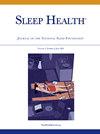Association of sleep patterns with microvascular complications in individuals with type 2 diabetes: A prospective cohort study
IF 3.4
2区 医学
Q2 CLINICAL NEUROLOGY
引用次数: 0
Abstract
Background
This study aimed to explore the association between sleep patterns and the risk of microvascular complications in patients with type 2 diabetes.
Methods and results
Using UK Biobank data, we included the findings for 19,996 patients with type 2 diabetes who were free of diabetic microvascular complications at baseline. The sleep-pattern score was calculated as the sum of the scores for six low-risk sleep-pattern behaviors encompassing sleep duration, chronotype, daytime sleepiness, snoring, insomnia, and daytime napping. Each point increase in sleep-pattern scores is associated with 7%, 15%, and 5% decreased risk of diabetic microvascular complications, nerve, and kidney complications, respectively. Over a median follow-up period of 13.2 years, 5635 participants developed diabetic microvascular complications. The hazard ratio (HR; 99% confidence interval [CI]) for diabetic microvascular complications was 1.13 (1.02, 1.25) in participants with >8 hours of sleep vs. those with 7-8 hours of sleep and 1.13 (1.02, 1.24) in participants who usually showed insomnia behaviors vs. those who never or rarely showed insomnia behaviors. The HR (99% CI) for diabetic neuropathy was 1.52 (1.19, 1.85) in participants who usually showed insomnia behaviors vs. those who never or rarely showed insomnia behaviors. The HR (99% CI) for diabetic microvascular complications and diabetic kidney disease was 1.20 (1.06, 1.33) and 1.24 (1.07, 1.42), respectively, in participants who usually showed daytime napping behaviors vs. those who never or rarely showed these behaviors.
Conclusions
Several sleep behaviors were associated with higher risks of diabetic microvascular complications in patients with type 2 diabetes.
2型糖尿病患者睡眠模式与微血管并发症的关系:一项前瞻性队列研究
背景:本研究旨在探讨2型糖尿病患者睡眠模式与微血管并发症风险之间的关系。方法和结果:使用UK Biobank数据,我们纳入了19,996例基线时无糖尿病微血管并发症的2型糖尿病患者的研究结果。睡眠模式得分是根据六种低风险睡眠模式行为的得分之和计算得出的,这些行为包括睡眠时间、睡眠类型、白天嗜睡、打鼾、失眠和白天打盹。睡眠模式评分每增加一分,糖尿病微血管并发症、神经和肾脏并发症的风险分别降低7%、15%和5%。在平均13.2年的随访期间,5635名参与者出现了糖尿病微血管并发症。风险比(HR;睡眠不足8小时组与睡眠不足7-8小时组糖尿病微血管并发症的99%可信区间[CI]分别为1.13(1.02,1.25)和1.13(1.02,1.24);经常出现失眠行为组与从不或很少出现失眠行为组的糖尿病微血管并发症的99%可信区间[CI]分别为1.13(1.02,1.24)。通常表现出失眠行为的参与者与从未或很少表现出失眠行为的参与者相比,糖尿病神经病变的HR (99% CI)为1.52(1.19,1.85)。通常有白天午睡行为的参与者与从不或很少有这些行为的参与者相比,糖尿病微血管并发症和糖尿病肾病的HR (99% CI)分别为1.20(1.06,1.33)和1.24(1.07,1.42)。结论:几种睡眠行为与2型糖尿病患者发生糖尿病微血管并发症的高风险相关。
本文章由计算机程序翻译,如有差异,请以英文原文为准。
求助全文
约1分钟内获得全文
求助全文
来源期刊

Sleep Health
CLINICAL NEUROLOGY-
CiteScore
6.30
自引率
9.80%
发文量
114
审稿时长
54 days
期刊介绍:
Sleep Health Journal of the National Sleep Foundation is a multidisciplinary journal that explores sleep''s role in population health and elucidates the social science perspective on sleep and health. Aligned with the National Sleep Foundation''s global authoritative, evidence-based voice for sleep health, the journal serves as the foremost publication for manuscripts that advance the sleep health of all members of society.The scope of the journal extends across diverse sleep-related fields, including anthropology, education, health services research, human development, international health, law, mental health, nursing, nutrition, psychology, public health, public policy, fatigue management, transportation, social work, and sociology. The journal welcomes original research articles, review articles, brief reports, special articles, letters to the editor, editorials, and commentaries.
 求助内容:
求助内容: 应助结果提醒方式:
应助结果提醒方式:


